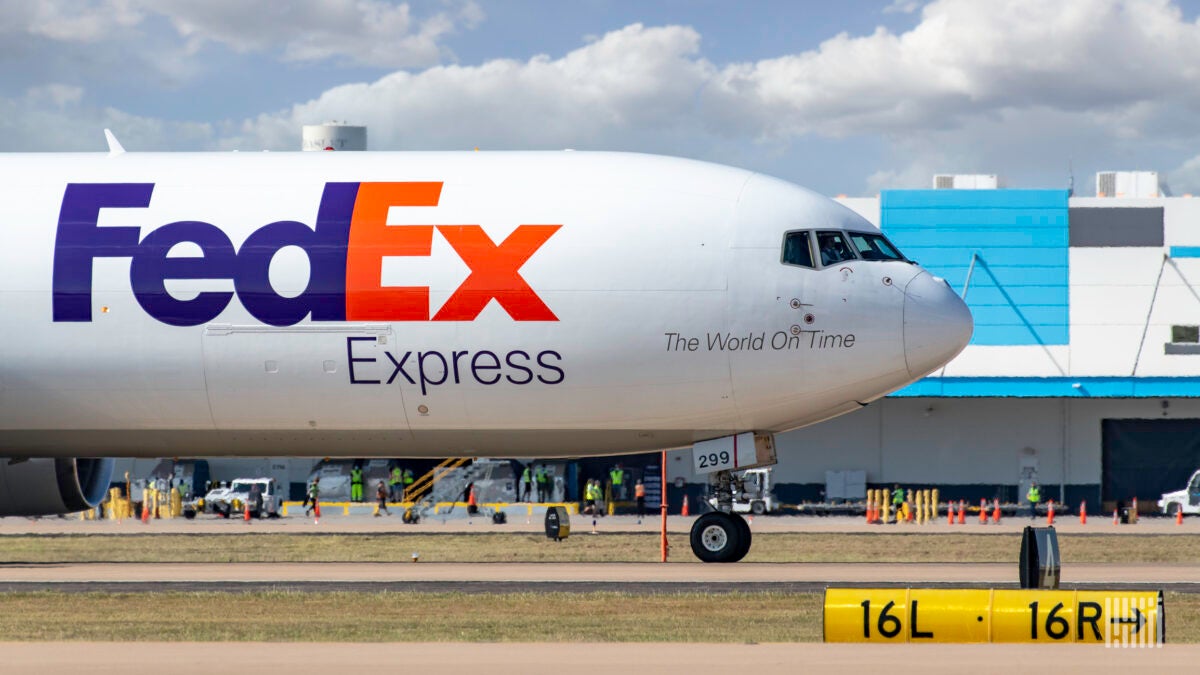FedEx is rolling out a new paint scheme for its freighter aircraft to reflect the combination underway of the Express and Ground networks, a strategic effort designed to increase efficiency and cut costs by reducing overlapping infrastructure.
The parcel delivery giant this year began covering cargo jets with new graphics to represent the unified brand under the One FedEx model, Justin Brownlee, senior vice president for flight operations and network planning, informed airline employees last week in a letter obtained by FreightWaves.
The rebranding, which has been applied to 18 freighters so far, no longer identifies the aircraft as belonging to FedEx Express. The logo now features larger FedEx lettering and different positioning to give a more modern look.
FedEx (NYSE: FDX) shared photos of the new aircraft livery at FreightWaves’ request.
FedEx also plans to update its ground fleet with the new brand image on a rolling basis, said Caitlin Adams Maier, director of global media and public affairs. The new livery will be placed on any new vehicles purchased as replacements. The updated design will also be applied to any vehicles that come in for body repairs where the current branding is impacted. Aircraft rebranded during normal repainting cycles.
Changing the livery on the entire vehicle and plane fleet will take several years, she added. A gradual process ensures equipment will remain available for duty to the maximum extent possible.
Network 2.0 transformation
Last month, the company declared that FedEx Express, FedEx Ground and FedEx Services (the group that provides IT, sales and marketing support) had been consolidated into one organization, Federal Express Corp. While the management structure is now under one roof, physically implementing the merger will take time. The closed-loop logistics provider last year began tearing down operational silos in the U.S. between Express and Ground, and now has combined delivery operations at more than 50 locations.
For decades, the two units operated separately with their own workforces and fleets. Time-sensitive packages are pushed to Express. Ground, which uses independent contractors who employ their own delivery drivers, handles less urgent packages.
Under the strategy detailed in April 2023, first- and last-mile delivery will be served by a single network. FedEx executives have said they expect to complete the network integration in Canada in October. FedEx Freight, the less-than-truckload business, and Ground linehaul are also sharing equipment and coordinating routes more than in the past.

FedEx built its business on the concept that units which operated separately could offer unique capabilities and respond more effectively to customer needs using tailored services. As profit levels narrowed in recent years, the management team under new CEO Raj Subramaniam decided that the operations had become less efficient and too disjointed to easily manage. The eventual goal of consolidation is to realize $2 billion in annualized savings.
The faster FedEx can synchronize Express and Ground operations, the sooner it can start saving money. Implementation challenges include modifying certain Ground facilities to handle airfreight containers and harmonizing technology.
FreightWaves last week reported that FedEx plans a 60% drawdown of its daytime domestic air network – flight hours and cities served – after its contract with the U.S. Postal Service expires at the end of September. The end of the postal commitment represents a substantial revenue loss but also frees up FedEx to streamline an underutilized daytime air operation and significantly cut costs.
Brownlee acknowledged in the internal correspondence that loss of Postal Service business will create a surplus of 500 pilots, adding to overstaffing that already existed as FedEx copes with a global downturn in parcel volumes. FreightWaves estimates that FedEx has about 900 more pilots than currently needed to fly domestic and international routes.
The letter also listed several routes FedEx is launching to cater to non-parcel customers through its new Orange network, which targets deferred, premium cargo, and the launch of an intra-China route in partnership with a Chinese cargo airline.
Click here for more FreightWaves/American Shipper stories by Eric Kulisch.
RECOMMENDED READING:
FedEx to cut daytime domestic flight activity by 60%
FedEx retires one-fifth of Boeing 757 freighter fleet
UPS wins air cargo contract with Postal Service, replaces FedEx







